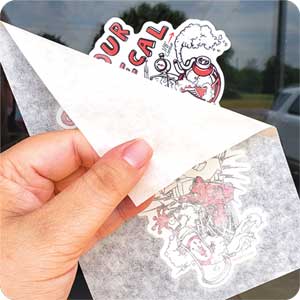Applying Vinyl Decals

Learn the best DIY way to apply your vinyl decals in a just few easy steps. These How To tips will help ensure that you get a professional looking application without air bubbles.
When installing vinyl, it's important you apply your product to the best possible surface. The list below contains a brief summary of acceptable surfaces, along with some surfaces that are not.
As a general rule of thumb, vinyl will stick to almost any surface that is clean, smooth, and nonporous. To demonstrate the necessary surface qualities, we use glass versus brick as a quick example. Vinyl will stick very well to glass because of its high gloss smooth surface, but it won't stick well to brick at all due to the rough texture cutting down on the surface area available to the adhesive.
Design your own custom vinyl decals.
Acceptable Surfaces
*Glass
*Metals (Ideally should be painted with a smooth, glossy enamel)
*Vehicles (Ideally should be painted with a smooth, glossy enamel)
*Vinyl (Such as banners, canopies, flags, etc.)
*Plastic, Acrylic and other high gloss surfaces.
*Fiberglass (Must be painted with a smooth, glossy enamel)
*Wood (Must be painted with a smooth, glossy enamel)
*Other Painted Surfaces (Paint must be smooth and glossy, vinyl will not stick to oxidized, faded, or peeling paint)
Not Recommended Surfaces
*Pitted Cement
*Raw Lumber, like chip board or low grade plywood.
*Oxidized or Faded Paint
*Textured plastic surfaces
*Rubber
*Rusted Metals
*Oily Surfaces
*Dusty surfaces, like fresh drywall
These lists are not comprehensive and there are other acceptable and unacceptable surfaces beyond those listed. Again, when in doubt, apply the rule that states vinyl will generally adhere well to smooth, glossy, and clean surfaces. Rough, dull, peeling, porous, or dirty surfaces on the other hand will likely not produce an acceptable vinyl application.
For proper adherence, all surfaces should be considered dirty and should be cleaned prior to any vinyl application. Household surface cleaners, such as Windex, are acceptable; however, we recommend a 2-to-1 mixture of water and isopropyl alcohol. After thoroughly washing, wipe the surface dry with a clean, dry, lint-free cloth.
Air and surface temperature must be above 55 degrees Fahrenheit for the application of the vinyl. Apply the vinyl using the following steps:
(Note: It is recommended that a novice installer have a helper present for assistance with the following steps. It is not a requirement however it will help ensure a quality installation.)
Measure and mark the area you wish to apply your vinyl using a water-soluble pencil. Water soluble pencils are available on our vinyl application accessory pages. The blue water-soluble pencils are good for white surfaces. Precision marking will help assure a level application. Once you have the overall area defined and marked, you should have a good idea as to where the upper right and left corners of the decal should be placed. At this time, take your decal (paper and all) and tape the right upper corner of it to your predetermined area. Have your assistant hold the upper left corner of the decal in place while you stand back a few feet and look at it. If you like it's placement, move on to the next step.
Tape the left corner in place and put a piece of tape down the center of the decal. At this time, using your water-soluble pencil, place a mark on the right and left side of the decal. Make sure you mark both the tape and the surface you are mounting the decal to. You will be aligning these two marks later, so be sure you can see them clearly.
On the left side of the decal, hold the paper and peel off the tape until you reach the center of the decal. The decal should stay stuck to the application tape at this time. Cut the paper as close to the center as you can, without scratching your surface.
Spray the surface on the left side with water or application fluid (we recommend the application fluid). Do not spray water or application fluid when using reflective vinyl. Reflective vinyl should be applied on a dry surface. Place the left side of the decal down on the surface, taking care to line up the lines you drew in the previous step. With the application tape still intact, squeegee the decal to the surface by applying pressure with smooth even strokes. Start at the middle of the decal and work your way out to the left. Note: Before you squeegee, make sure there are no wrinkles in the decal or application tape.
Lift up the right side of the decal and remove the remainder of the backing paper. (It is ok to lift up the piece of center tape at this time). Apply application fluid to the right side of the surface. Place the right side of the decal taking care to align your marks on the right side. Again, start at the middle and squeegee toward the right side of the decal. Note: Before you squeegee make sure there are no wrinkles in the decal or application tape.
It is a good Idea to wait just a couple of minutes before you remove the application tape. This allows the application fluid to begin drying and will prevent the decal from trying to come up. Once it is adhered to the surface, squeegee the entire decal a second time. Then carefully peel the tape off the entire decal.
It is common for some small bubbles to appear throughout the decal. These bubbles will disappear within a few weeks. If you have any major, bubbles you can eliminate them by carefully heating the area with a hair dryer or heat gun, puncturing them with a needle and applying pressure with your thumb. Note: You can do more damage than good by chasing the smaller bubbles. They will disappear as the vinyl breathes and the application fluid evaporates.
